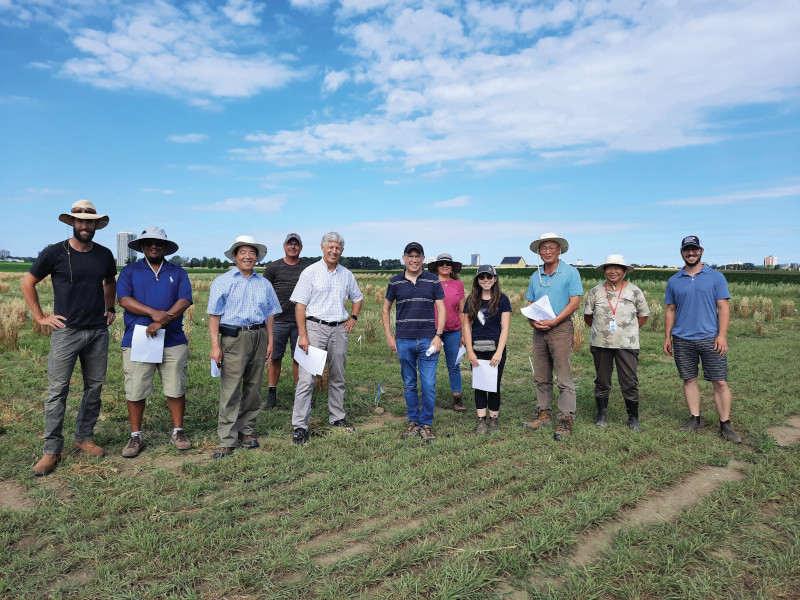Two new oat varieties are redefining what this time-honoured crop is capable of. But Jim Dyck says the future is uncertain if we can’t encourage more innovation in oat breeding.
Four years ago at the Ag in Motion trade show, oat breeder Jim Dyck stood in a field of oats next to a dartboard.
The targets labelled on the board — yield, standability, plumpness and milling quality — represented the qualities Dyck attempts to bring into new oat varieties through his private plant breeding business, Oat Advantage.
A handful of years later, two new oat varieties with all of these characteristics are set to launch in Western Canada. These varieties will be marketed by SeCan under the trade names ORe3541M and ORe3542M (or 41M and 42M) in time for spring 2019 planting.
The dartboard is still the perfect metaphor for Dyck’s efforts in oat breeding, says Todd Hyra, Western Canadian business manager for SeCan.
“Jim hasn’t given up one thing for the sake of another. These varieties offer a great combination of characteristics,” says Hyra.
Dyck says the varieties both offer good yields and standability as well as ease of harvest management. But it’s milling quality that makes 41M and 42M stand out.
According to Dyck, oats have traditionally been bred with an eye to yield first and milling quality second. While yield is important to growers, millers value kernel plumpness and are sometimes forced to discard a significant portion of thin oats to feed markets.
“We’ve decided not to keep anything in our program below 90 per cent plump,” says Dyck. “These two new varieties rate above 90 per cent plump, so there’s very little throwaway.”
He adds that all of Oat Advantage’s oat lines in development have this level of high-quality plump seed.
“Grain quality with these two varieties is really visible. Farmers will notice and millers will notice. Millers are already excited about getting their hands on these varieties. They look nice because they are nice — they have great grain quality,” he says.
What’s the story behind the names ORe3541M and ORe3542M? For Dyck, the names are symbolic. ORe stands for his “Oat Research series” but also for “Oats Re-defined.”
“I’ve heard people talk about oats as a messy hexaploidy — in genetics this refers to a crop that hasn’t been worked on much over the years, so there’s a lot of refinement that can go on,” says Dyck. “We want to redefine what oats are, to be a much better product.”
Murray Froebe of Agassiz Seed Farms near Homewood, Man., has grown 41M and 42M since 2017.
Froebe says the standout feature of both varieties, from the producers’ perspective, is standability. “Standability is crucial in the grower’s mind and these oats really deliver,” he says.
“The two oats are very similar — 41M has a smaller kernel but it can offer higher bushel weight. 42M is a bigger oat, but for the past year we’ve had no concerns on bushel weight,” he says.
Craig Riddell of Riddell Seed Company has grown both varieties for four years, starting with the initial breeder seed stock, on his operation at Warren, Man. “We have been most impressed with the consistency of these varieties’ superior grain quality,” says Riddell. “Through both wet years and this recent extremely dry year they have always been our heaviest test weight varieties. Some other popular varieties produced lower test weight for producers who missed the rains this year but 41M and 42M still had no issue making No. 1 grade specs.”
Tools for Success
Hyra says the fact that Dyck is an independent breeder is key to the positive message about his work.
“We want him and his breeding program to be successful long-term, and he makes his living based on how much seed we sell,” Hyra says.
For Dyck, it’s crucial that Canada adopt a system for value creation in cereals so that breeders like him can be successful and so growers can benefit from breeding innovations he says won’t be realized unless those innovations can be encouraged through either the end point royalty or trailing royalty system (his preferred option) currently on the table and being discussed among stakeholder groups.
“It’s key that growers recognize that oats can indeed make huge leaps forward. We’re already dreaming big, but we can’t realize those dreams if we don’t get some sort of system for value creation in Canada. We’ll barely be profitable with people buying certified seed of our new oat varieties, but with value creation in place we’ll be able to do things that right now we can only imagine,” Dyck says.
“Perhaps there’s a sentiment being expressed by some that we’re already doing enough, that there’s nothing big on the horizon that’s going to change the oat landscape. I disagree with that.”
—with additional material from Marc Zienkiewicz












